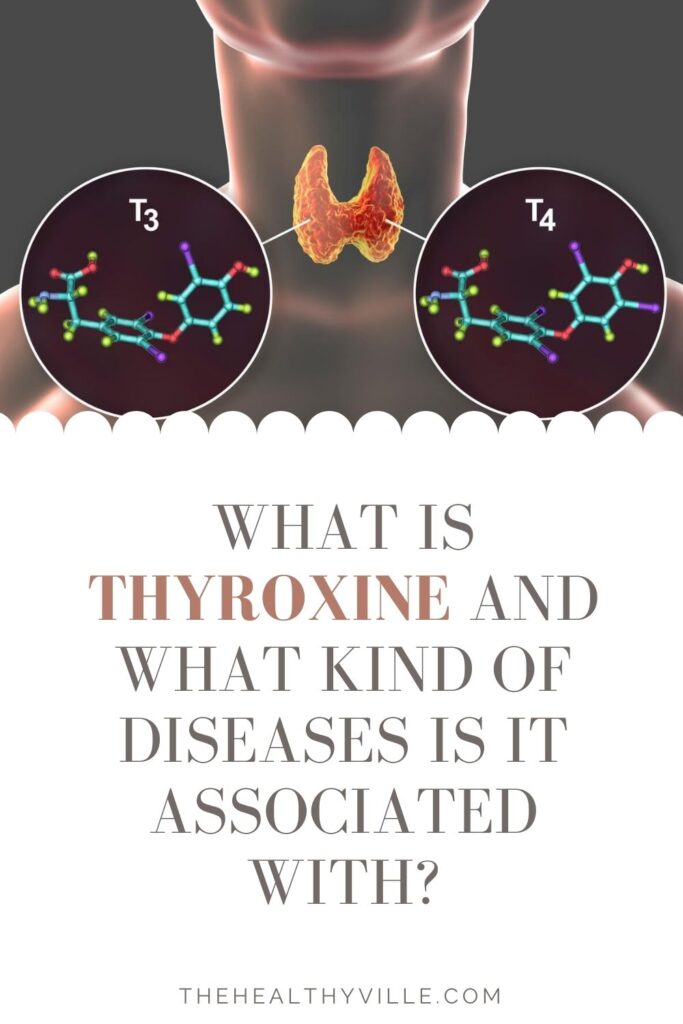What is thyroxine? Why do you need to monitor its function? What diseases can it cause? Find out everything you need to about it!
Thyroid hormones play an essential role in obtaining energy and in cellular metabolism. Thyroxine is the one which has specific qualities that allow it to perform its function.
The body has a series of substances synthesized in the glands, whose main function is to maintain homeostasis or balance in the body. All of these substances are called hormones. One of the most important is thyroxine.
The pathologies happen when there’s an alteration in concentration in the bloodstream, so they will not perform their function properly
What is thyroxine?
Also known T4, thyroxine is a hormone made from iodine and is synthesized and released from a gland located in the anterior region of the neck. It is composed of the condensation of the amino acid tyrosine, to which 2 atoms of iodine are added.
The amount of T4 the corresponding gland produces is much higher in relation to the other synthesized hormones, however, it has little biological activity. Thyroxine behaves like a prohormone in the periphery, that is, that it must transform into its active form by an enzymatic action.
The hypothalamus and pituitary regulate it. Both structures synthesize substances capable of stimulating or inhibiting the release of T4, according to the requirements of the organism.
Which gland is in charge of producing it?
The organ responsible for producing and releasing thyroxine into the bloodstream is the thyroid gland. Its location is in the anterior region of the neck, below the larynx and in front of the trachea. The thyroid anatomy resembles a shield: it has 2 lobes located on both sides of the trachea, joined by a central region called the isthmus.
When normally functioning, this gland is not palpable and weighs around 20 grams. It produces of different hormones, among which T4 or thyroxine and T3 or triiodothyronine stand out.
Thyroid hormones are synthesized in specialized structures of the gland which are the thyroid follicles. These follicles have a colloid substance in the centre, which has everything necessary for hormonal production. In this sense, it will contain enzymes, tyrosine, iodine and thyroglobulin.
What is the function of this hormone?
This hormone has a lower biological activity and a longer half-life than triiodothyronine. These make T4 the ideal substance to maintain a constant reserve.
In general terms, triiodothyronine will be the active form of thyroid hormones, while thyroxine will function as the plasma reserve. When you have low levels of T3, enzymes in will extract an iodine atom from thyroxine, transforming it into its active form.
Thyroid hormones play a crucial role in intrauterine life. They are essential to regulate the development and growth of the human being. They have the following functions:
- Promote cognitive development.
- Regulate cell metabolism.
- Production of energy.
- Maintain the function of the musculoskeletal system.
- Participate in bone metabolism.
- Alter the functioning of the digestive and cardiovascular system.
Diseases related to thyroxine deficiency
The main condition the lack of thyroxine and triiodothyronine can cause is hypothyroidism. In fact, this is a pathology doctors define as the decrease in the effect of thyroid hormones at the tissue level. The most common cause is a decrease in the production or release of thyroid hormones, although it can also appear due to peripheral resistance.
Hypothyroidism can be primary or secondary. It is primary when there is a dysfunction in the gland itself. While it is central or secondary when there is a decreased secretion of releasing factors at the level of the pituitary or hypothalamus.
Among the main causes of hypothyroidism, the following stand out:
- Hashimoto’s disease.
- Thyroidectomy.
- Radioactive treatment and certain medications.
- A lack or an excess of iodine in the body.
Thyroid hormone deficiency can lead to another condition called goiter, which is nothing more than an increase in the size of the thyroid gland. In fact, this increase in volume appears in order to capture more iodine and increase production.
Diseases related to excess thyroxine
Excess thyroxine and triiodothyronine in the bloodstream is hyperthyroidism. In fact, a wide variety of conditions that alter the functioning of the gland and increase hormonal production can cause it.
Among the main pathologies capable of causing hyperthyroidism, the following stand out:
- Graves-Basedow disease.
- Toxic multinodular goiter.
- Toxic adenoma.
- Thyroiditis.
This pathology is capable of increasing the basal metabolism of the human body, so that all the functions of the organism will accelerate. In this sense, people may experience palpitations, nervousness, weight loss, and increased sweating.
For its part, pregnancy can also cause an increase in thyroid hormone levels, especially in the first trimester. However, this increase is physiological.
An essential hormone for the body
Thyroxine is a hormone the thyroid gland produces that can transform into its active form in peripheral tissues, making it a reserve source. In fact, thyroid hormones fulfill essential functions within the body, almost all related to the regulation of basal metabolism and growth.
The pathologies associated with excess or deficit alter the basal metabolism, causing the appearance of uncomfortable and dangerous symptoms. The timely diagnosis and treatment of these pathologies will guarantee an adequate control of them and will prevent the appearance of complications.
Don’t forget to SHARE what is thyroxine with your friends and family on your social networks!

